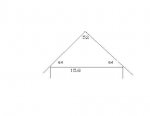question is:
A cottage under construction is to be 15.6 m wide. The two sides of the roof are to be supported by equal rafters that meet at a 52 degree angle. Determine the length of the raters to the nearest cm using (i) cosine Law and (ii) Sine Law.
what i am having trouble with is that since we are only given one length and one angle how can we apply the two laws. We need more information. Also i think to start this question we would have to find the angles first that can be done by using the 180 degree rule since the two sides of the roof are equal the angles of them would be 64 degress each but them i am not sure what to do from there.. Please Help me
[attachment=0]quest # 62.JPG[attachment]
A cottage under construction is to be 15.6 m wide. The two sides of the roof are to be supported by equal rafters that meet at a 52 degree angle. Determine the length of the raters to the nearest cm using (i) cosine Law and (ii) Sine Law.
what i am having trouble with is that since we are only given one length and one angle how can we apply the two laws. We need more information. Also i think to start this question we would have to find the angles first that can be done by using the 180 degree rule since the two sides of the roof are equal the angles of them would be 64 degress each but them i am not sure what to do from there.. Please Help me
[attachment=0]quest # 62.JPG[attachment]

